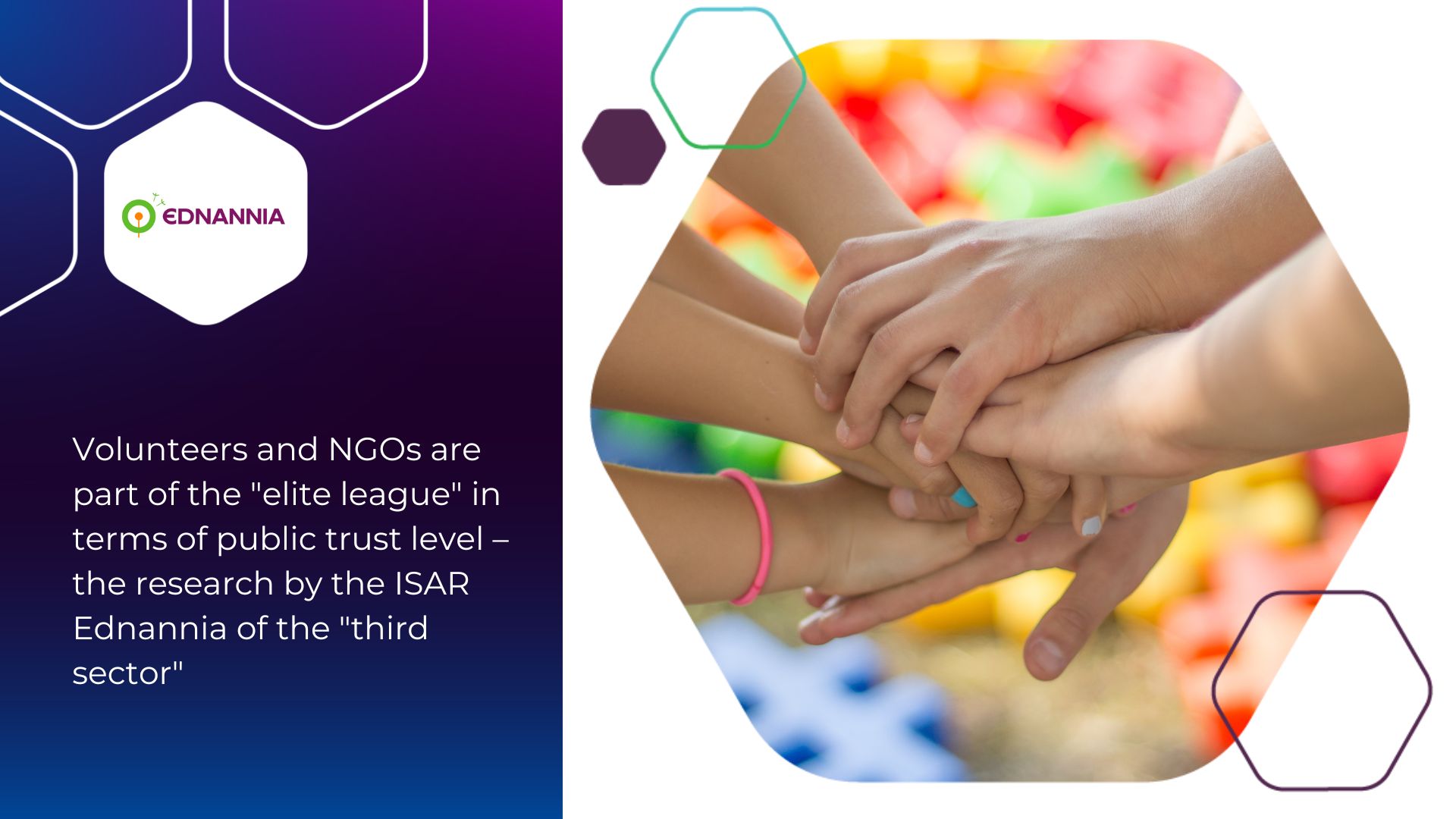
Since the full-scale Russian invasion, trust in volunteer and civil society organizations (CSOs) from the side of Ukrainian society has been increased. Today, both volunteers and CSOs are among more trusted civic actors in Ukraine. However, the level of trust toward volunteers remains higher in comparison with CSOs.
This conclusion was made according to a recent research "Civil Society in Ukraine in the Context of War" (see also the Ukrainian version) initiated by ISAR Ednannia and conducted by the Kyiv International Institute of Sociology as part of the project "Ukraine Civil Society Sectoral Support Activity". This initiative was implemented by ISAR Ednannia in partnership with Ukrainian Center of Independent Political Research (UCIPR) and Centre for Democracy and Rule of Law (CEDEM). It was possible by generous support of the American people provided through the United States Agency for International Development (The content of the report does not necessarily reflect the views of ISAR Ednannia, the United States Agency for International Development, or the United States Government).
Throughout 2023, there was a slight reduction in credibility toward both entities: at the fall of 2023, 84% of people trusted volunteers (compared to 88% at the beginning of the year), and 61% trusted CSOs (compared to 66% at the beginning of the year). The study emphasizes relative deduction in trust for government authorities from December 2022 to December 2023, the decrease in trust in volunteers and CSOs is much smaller in scale. Additionally, approximately half of Ukrainians believe that CSOs are more effective in addressing social issues than government and businesses.
"ISAR Ednannia has been conducting a sociological check-up of Ukrainian civil and volunteer organizations for the fourth consecutive year, and for the second time after the full-scale Russian invasion," commented Volodymyr Sheyhus, Executive Director at ISAR Ednannia. "From the report, it is clear that CSOs have already adapted to the conditions of war, with 80% of them not only continuing their activities in Ukraine but also taking responsibility for new areas such as humanitarian response, veteran movements, and country recovery."
Also, the report "Civil Society in Ukraine in the Context of War" includes an analysis of other topics related to CSOs:
1) Activity areas of civil society organizations and volunteers: assistance to Ukrainian Forces and victims of Russian aggression became the main direction of activity for civil society with the onset of full-scale war. However, in 2023, the proportion of organizations for which support for the Army and victims of Russian invasion were the main areas of activity decreased by 5% (from 43% in 2022 to 38% in 2023). The number of institutions providing assistance to war-affected individuals decreased even more noticeably - by 11% (from 43% in 2022 to 32% in 2023). Additionally, about 10% of NGOs, CSOs, and volunteer initiatives engage in international advocacy. Changes in priority areas of activity occurred in nearly a quarter (23%) of CSOs over the past year, while 77% of organizations continued to work in their usual areas during the second year of the war.
Areas where increased involvement of CSOs has been observed over the past year include: (1) work with adolescents and youth (increase by 29%); (2) assistance to vulnerable populations and people with special needs (increase by 14%); and (3) healthcare (increase by 7%). The main directions of volunteer work are focused on assisting the Armed Forces of Ukraine (46%), providing volunteer assistance to victims of Russian aggression (26%), humanitarian aid to the population (20%), and assistance to people with disabilities (16%).
2) Quantitative indicators and dynamics of the sector: from 2021 to 2023, the number of charitable organizations (COs) increased the most - by 43%. The number of NGOs and homeowners' associations (HOAs) also increased by 6.1% and 5.4% respectively. In 2023, there was a significant number of registrations of new COs - almost 5,000 (for comparison: in 2022, there were over 6,000 new registrations). In 2023, the highest number of NGOs and COs were registered in Kyiv, Dnipropetrovsk, Lviv, Kharkiv, Kyiv and Odesa regions. Although the list of leading regions in 2023 remained almost the same as the previous year, changes in the pace of creating new organizations by region are interesting: the largest increase was demonstrated by the Kherson region.
The number of registered volunteers in Ukraine significantly increased after the start of the full-scale invasion, especially since October 2022: from 320 individuals in January 2022 to almost 7,000 by the end of 2023. However, much volunteer activity occurs outside of official registration, so the actual scale of volunteering in the country is much broader.
3) Characteristics of organizations based on the research results in 2023 and comparison with the results of 2022: approximately 6.3% of civil society organizations were forced to relocate from active combat zones, with the majority of relocations (4.9%) occurring in 2022. The relocation process slowed down in 2023.
Half of civil society organizations and volunteers (49%) have a local geographical scope of activity, operating in individual settlements, communities, or regions. 24% consider themselves as a national organization, 18% are regional organizations operating in several regions, and 10% are international NGOs. There is a significant distinction between CSOs and volunteer initiatives: CSOs are more focused on the local level, while volunteers operate on a national scale.
4) Target audiences of CSOs: according to CSOs and volunteers, in 2023, the groups of people most in need of assistance are those whose lives are most affected by the war: military personnel, war veterans and their families, residents of frontline and liberated regions, and internally displaced persons (IDPs). Over half of the respondents also mentioned people with disabilities. Large part of participants agree that the needs for assistance of almost all categories of individuals have increased rather than decreased over the past year. At the same time, nearly one in five respondents believes that IDPs and Ukrainians abroad have needed less assistance over the past year.
5) Cooperation between NGOs and volunteers with state authorities and local self-government: four out of ten NGOs and volunteer initiatives received invitations for cooperation from government agencies or local self-government (almost the same as in 2022). NGOs and volunteers are most likely to establish productive working relationships with local self-government and least likely with central government. 25% of surveyed NGOs and volunteers reported having established good communication with central government agencies, 39% with local executive authorities, and 46% with local councils.
6) Main challenges and needs of NGOs and volunteers in 2023: the key issues in the activities of NGOs relate to financial support (58%) and personnel issues - team burnout, excessive workload, and staff shortages (34%). The proportion of NGOs reporting these difficulties slightly increased in 2023 compared to 2022. However, the prevalence of problems with technical support (28%) remained unchanged, and issues related to office and communication facilities (26%), physical safety of the team and organization's property (21%), and work organization (20%) even decreased.
7) NGOs Plans for 2024: the four most mentioned directions at work for NGOs in 2024 are closely related to overcoming the consequences of war: reconstruction of infrastructure and housing, rehabilitation and support for wounded soldiers, their families, and victims of combat actions, social and psychological assistance to a wide range of war-affected individuals. Strategic goals of NGOs for 2024 mentioned by representatives of the civil society sector and experts during in-depth interviews, they are also diverse: including strengthening the sustainability and institutional capacity of the NGOs themselves, as well as a wide range of tasks for the recovery, development, and strengthening of Ukraine in the conditions of war.
8) Access of NGOs to sources of funding: two-thirds of organizations indicated that the main sources of funding in 2023 remains donations, membership fees, or contributions. International grants possess the second place (22%), while incomes from their own economic activities are used by 18%. The proportion of organizations receiving funding from the government or local budget has slightly increased (in 2023 - 7.9%, compared to 5.6% in the previous year).
The sources of funding for NGOs and volunteer initiatives are mostly similar. However, volunteers more often get donations and contributions from the individuals, local businesses, and civic activists in comparison to NGOs. The respondents keep the opinion that international donors are a key source in funding for Ukrainian NGOs. In 2023, according to the experts’ findings, donors increased the volume of financial support, and the number of donors in Ukraine also increased. Representatives of NGOs believe that the volume of charitable contributions/donations from the citizens significantly decreased in 2023 in comparison with beginning of full-scale invasion.

